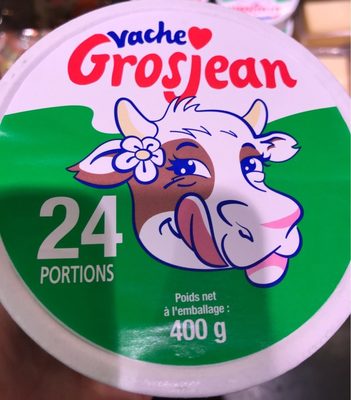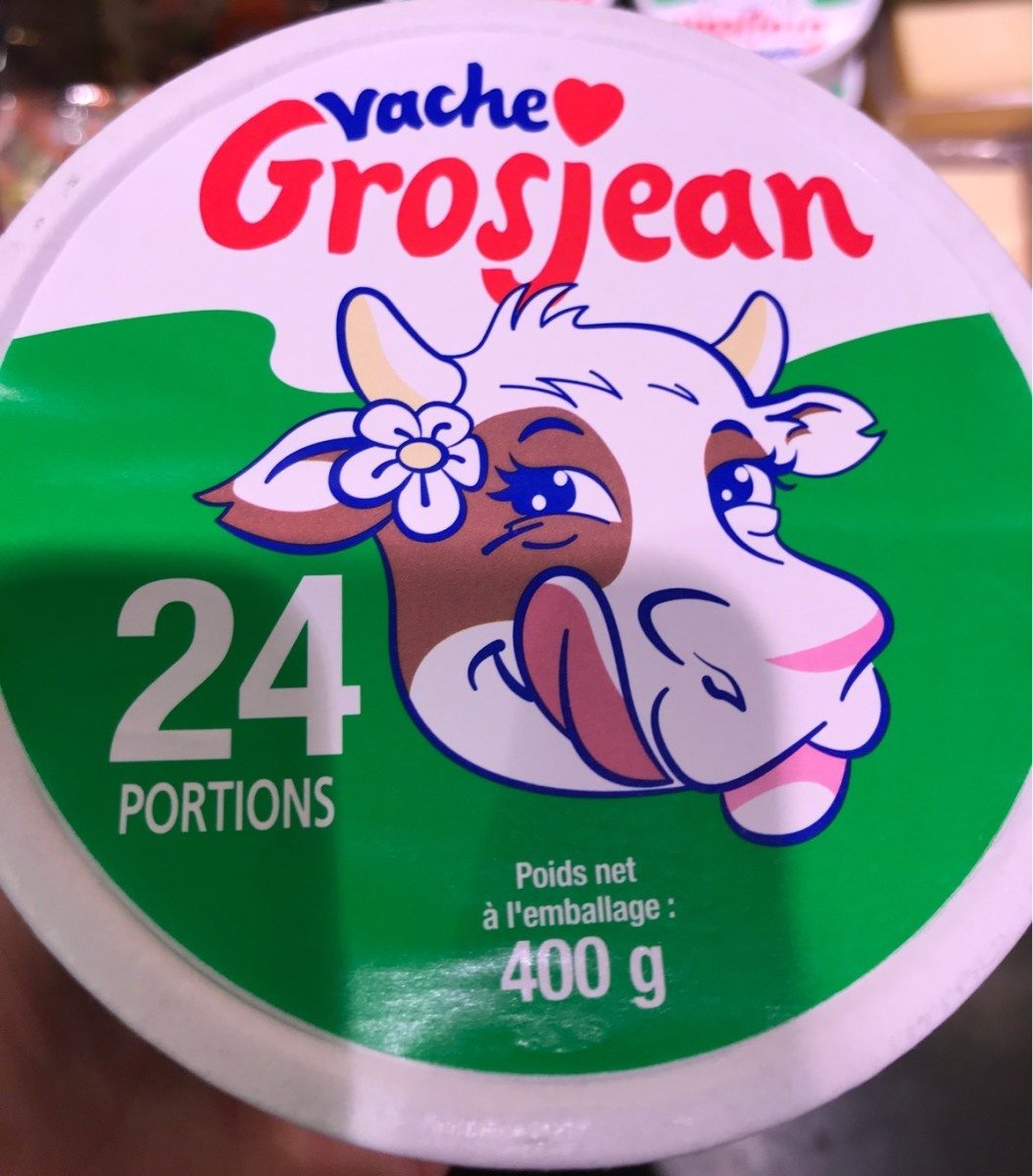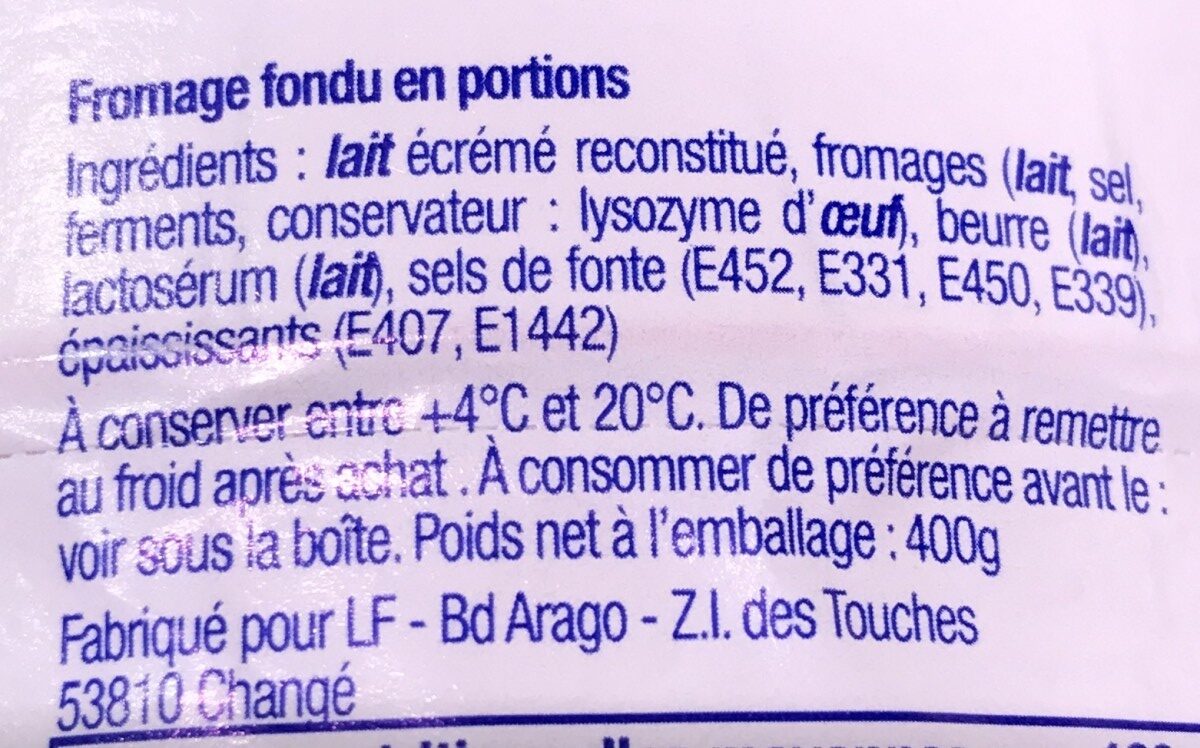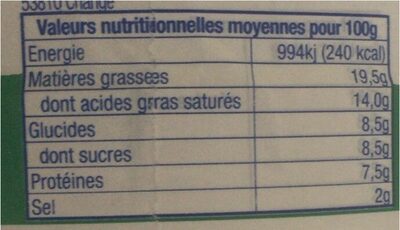Help us make food transparency the norm!
As a non-profit organization, we depend on your donations to continue informing consumers around the world about what they eat.
The food revolution starts with you!
Vache grosjean - - 400 g
Vache grosjean - - 400 g
This product page is not complete. You can help to complete it by editing it and adding more data from the photos we have, or by taking more photos using the app for Android or iPhone/iPad. Thank you!
×
Barcode: 3228022160107 (EAN / EAN-13)
Quantity: 400 g
Categories: Dairies, Fermented foods, Fermented milk products, Cheeses, Fromages, Produits fermentés, Produits laitiers, Produits laitiers fermentés
Traceability code: FR 39.300.002 CE - Lons-le-Saunier (Jura, France)
Countries where sold: France
Matching with your preferences
Health
Ingredients
-
20 ingredients
: Lait écrémé reconstitué, fromages (lait, sel, ferments, conservateur : lysozyme d'euf, beurre (lait), lactosérum (lait, sels de fonte (E452, E331, E450, E339), ópaississants (E407, E1442) À conserver entrC +4°C et 20°C. De préférence à remettre au froidAllergens: Milk
Food processing
-
Ultra processed foods
Elements that indicate the product is in the 4 - Ultra processed food and drink products group:
- Additive: E1442 - Hydroxypropyl distarch phosphate
- Additive: E407 - Carrageenan
- Additive: E450 - Diphosphates
- Additive: E452 - Polyphosphates
- Ingredient: Whey
Food products are classified into 4 groups according to their degree of processing:
- Unprocessed or minimally processed foods
- Processed culinary ingredients
- Processed foods
- Ultra processed foods
The determination of the group is based on the category of the product and on the ingredients it contains.
Additives
-
E1442 - Hydroxypropyl distarch phosphate
Hydroxypropyl distarch phosphate: Hydroxypropyl distarch phosphate -HDP- is a modified resistant starch. It is currently used as a food additive -INS number 1442-. It is approved for use in the European Union -listed as E1442-, the United States, Australia, Taiwan, and New Zealand.Source: Wikipedia
-
E331 - Sodium citrates
Sodium citrate: Sodium citrate may refer to any of the sodium salts of citrate -though most commonly the third-: Monosodium citrate Disodium citrate Trisodium citrateThe three forms of the salt are collectively known by the E number E331. Sodium citrates are used as acidity regulators in food and drinks, and also as emulsifiers for oils. They enable cheeses to melt without becoming greasy.Source: Wikipedia
-
E339 - Sodium phosphates
Sodium phosphates: Sodium phosphate is a generic term for a variety of salts of sodium -Na+- and phosphate -PO43−-. Phosphate also forms families or condensed anions including di-, tri-, tetra-, and polyphosphates. Most of these salts are known in both anhydrous -water-free- and hydrated forms. The hydrates are more common than the anhydrous forms.Source: Wikipedia
-
E407 - Carrageenan
Carrageenan (E407), derived from red seaweed, is widely employed in the food industry as a gelling, thickening, and stabilizing agent, notably in dairy and meat products.
It can exist in various forms, each imparting distinct textural properties to food.
However, its degraded form, often referred to as poligeenan, has raised health concerns due to its potential inflammatory effects and its classification as a possible human carcinogen (Group 2B) by the International Agency for Research on Cancer (IARC).
Nevertheless, food-grade carrageenan has been deemed safe by various regulatory bodies when consumed in amounts typically found in food.
-
E450 - Diphosphates
Diphosphates (E450) are food additives often utilized to modify the texture of products, acting as leavening agents in baking and preventing the coagulation of canned food.
These salts can stabilize whipped cream and are also found in powdered products to maintain their flow properties. They are commonly present in baked goods, processed meats, and soft drinks.
Derived from phosphoric acid, they're part of our daily phosphate intake, which often surpasses recommended levels due to the prevalence of phosphates in processed foods and drinks.
Excessive phosphate consumption is linked to health issues, such as impaired kidney function and weakened bone health. Though diphosphates are generally regarded as safe when consumed within established acceptable daily intakes, it's imperative to monitor overall phosphate consumption to maintain optimal health.
Ingredients analysis
-
Palm oil content unknown
Unrecognized ingredients: fr:lysozyme-d-euf, fr:opaississants, fr:a-conserver-entrc-4-c-et-20-c, fr:de-preference-a-remettre-au-froidSome ingredients could not be recognized.
We need your help!
You can help us recognize more ingredients and better analyze the list of ingredients for this product and others:
- Edit this product page to correct spelling mistakes in the ingredients list, and/or to remove ingredients in other languages and sentences that are not related to the ingredients.
- Add new entries, synonyms or translations to our multilingual lists of ingredients, ingredient processing methods, and labels.
If you would like to help, join the #ingredients channel on our Slack discussion space and/or learn about ingredients analysis on our wiki. Thank you!
-
Non-vegan
Non-vegan ingredients: fr:Lait écrémé reconstitué, Cheese, Milk, Butter, Whey, MilkSome ingredients could not be recognized.
We need your help!
You can help us recognize more ingredients and better analyze the list of ingredients for this product and others:
- Edit this product page to correct spelling mistakes in the ingredients list, and/or to remove ingredients in other languages and sentences that are not related to the ingredients.
- Add new entries, synonyms or translations to our multilingual lists of ingredients, ingredient processing methods, and labels.
If you would like to help, join the #ingredients channel on our Slack discussion space and/or learn about ingredients analysis on our wiki. Thank you!
-
Vegetarian status unknown
Unrecognized ingredients: fr:lysozyme-d-euf, fr:opaississants, fr:a-conserver-entrc-4-c-et-20-c, fr:de-preference-a-remettre-au-froidSome ingredients could not be recognized.
We need your help!
You can help us recognize more ingredients and better analyze the list of ingredients for this product and others:
- Edit this product page to correct spelling mistakes in the ingredients list, and/or to remove ingredients in other languages and sentences that are not related to the ingredients.
- Add new entries, synonyms or translations to our multilingual lists of ingredients, ingredient processing methods, and labels.
If you would like to help, join the #ingredients channel on our Slack discussion space and/or learn about ingredients analysis on our wiki. Thank you!
-
Details of the analysis of the ingredients
We need your help!
Some ingredients could not be recognized.
We need your help!
You can help us recognize more ingredients and better analyze the list of ingredients for this product and others:
- Edit this product page to correct spelling mistakes in the ingredients list, and/or to remove ingredients in other languages and sentences that are not related to the ingredients.
- Add new entries, synonyms or translations to our multilingual lists of ingredients, ingredient processing methods, and labels.
If you would like to help, join the #ingredients channel on our Slack discussion space and/or learn about ingredients analysis on our wiki. Thank you!
: Lait écrémé reconstitué, fromages, lait, sel, ferments, conservateur (lysozyme d'euf), beurre, lactosérum, lait, sels de fonte (e452, e331, e450, e339), ópaississants (e407, e1442), À conserver entrC +4°C et 20°C, De préférence à remettre au froid- Lait écrémé reconstitué -> fr:lait-ecreme-reconstitue - vegan: no - vegetarian: yes - ciqual_proxy_food_code: 19051 - percent_min: 7.69230769230769 - percent_max: 100
- fromages -> en:cheese - vegan: no - vegetarian: maybe - ciqual_proxy_food_code: 12999 - percent_min: 0 - percent_max: 50
- lait -> en:milk - vegan: no - vegetarian: yes - ciqual_proxy_food_code: 19051 - percent_min: 0 - percent_max: 33.3333333333333
- sel -> en:salt - vegan: yes - vegetarian: yes - ciqual_food_code: 11058 - percent_min: 0 - percent_max: 2
- ferments -> en:ferment - vegan: maybe - vegetarian: maybe - percent_min: 0 - percent_max: 2
- conservateur -> en:preservative - percent_min: 0 - percent_max: 2
- lysozyme d'euf -> fr:lysozyme-d-euf - percent_min: 0 - percent_max: 2
- beurre -> en:butter - vegan: no - vegetarian: yes - ciqual_proxy_food_code: 16400 - percent_min: 0 - percent_max: 2
- lactosérum -> en:whey - vegan: no - vegetarian: maybe - percent_min: 0 - percent_max: 2
- lait -> en:milk - vegan: no - vegetarian: yes - ciqual_proxy_food_code: 19051 - percent_min: 0 - percent_max: 2
- sels de fonte -> en:emulsifying-salts - percent_min: 0 - percent_max: 2
- e452 -> en:e452 - vegan: yes - vegetarian: yes - percent_min: 0 - percent_max: 2
- e331 -> en:e331 - vegan: yes - vegetarian: yes - percent_min: 0 - percent_max: 1
- e450 -> en:e450 - vegan: yes - vegetarian: yes - percent_min: 0 - percent_max: 0.666666666666667
- e339 -> en:e339 - vegan: yes - vegetarian: yes - percent_min: 0 - percent_max: 0.5
- ópaississants -> fr:opaississants - percent_min: 0 - percent_max: 2
- e407 -> en:e407 - vegan: yes - vegetarian: yes - percent_min: 0 - percent_max: 2
- e1442 -> en:e1442 - vegan: yes - vegetarian: yes - percent_min: 0 - percent_max: 1
- À conserver entrC +4°C et 20°C -> fr:a-conserver-entrc-4-c-et-20-c - percent_min: 0 - percent_max: 2
- De préférence à remettre au froid -> fr:de-preference-a-remettre-au-froid - percent_min: 0 - percent_max: 2
Nutrition
-
Poor nutritional quality
⚠ ️Warning: the amount of fiber is not specified, their possible positive contribution to the grade could not be taken into account.⚠ ️Warning: the amount of fruits, vegetables and nuts is not specified on the label, it was estimated from the list of ingredients: 0This product is not considered a beverage for the calculation of the Nutri-Score.
Positive points: 4
- Proteins: 4 / 5 (value: 7.5, rounded value: 7.5)
- Fiber: 0 / 5 (value: 0, rounded value: 0)
- Fruits, vegetables, nuts, and colza/walnut/olive oils: 0 / 5 (value: 0, rounded value: 0)
Negative points: 21
- Energy: 2 / 10 (value: 1004, rounded value: 1004)
- Sugars: 1 / 10 (value: 8.5, rounded value: 8.5)
- Saturated fat: 10 / 10 (value: 14, rounded value: 14)
- Sodium: 8 / 10 (value: 800, rounded value: 800)
The points for proteins are counted because the product is in the cheeses category.
Nutritional score: (21 - 4)
Nutri-Score:
-
Nutrient levels
-
Fat in moderate quantity (19.5%)
What you need to know- A high consumption of fat, especially saturated fats, can raise cholesterol, which increases the risk of heart diseases.
Recommendation: Limit the consumption of fat and saturated fat- Choose products with lower fat and saturated fat content.
-
Saturated fat in high quantity (14%)
What you need to know- A high consumption of fat, especially saturated fats, can raise cholesterol, which increases the risk of heart diseases.
Recommendation: Limit the consumption of fat and saturated fat- Choose products with lower fat and saturated fat content.
-
Sugars in moderate quantity (8.5%)
What you need to know- A high consumption of sugar can cause weight gain and tooth decay. It also augments the risk of type 2 diabetes and cardio-vascular diseases.
Recommendation: Limit the consumption of sugar and sugary drinks- Sugary drinks (such as sodas, fruit beverages, and fruit juices and nectars) should be limited as much as possible (no more than 1 glass a day).
- Choose products with lower sugar content and reduce the consumption of products with added sugars.
-
Salt in high quantity (2%)
What you need to know- A high consumption of salt (or sodium) can cause raised blood pressure, which can increase the risk of heart disease and stroke.
- Many people who have high blood pressure do not know it, as there are often no symptoms.
- Most people consume too much salt (on average 9 to 12 grams per day), around twice the recommended maximum level of intake.
Recommendation: Limit the consumption of salt and salted food- Reduce the quantity of salt used when cooking, and don't salt again at the table.
- Limit the consumption of salty snacks and choose products with lower salt content.
-
-
Nutrition facts
Nutrition facts As sold
for 100 g / 100 mlCompared to: Fromages Energy 1,004 kj
(240 kcal)-18% Fat 19.5 g -17% Saturated fat 14 g -9% Carbohydrates 8.5 g +303% Sugars 8.5 g +438% Fiber ? Proteins 7.5 g -53% Salt 2 g +50% Fruits‚ vegetables‚ nuts and rapeseed‚ walnut and olive oils (estimate from ingredients list analysis) 0 %
Environment
-
Eco-Score D - High environmental impact
⚠ ️Select a country in order to include the full impact of transportation.The Eco-Score is an experimental score that summarizes the environmental impacts of food products.→ The Eco-Score was initially developped for France and it is being extended to other European countries. The Eco-Score formula is subject to change as it is regularly improved to make it more precise and better suited to each country.Life cycle analysis
-
Average impact of products of the same category: C (Score: 54/100)
Category: Camembert cheese, from cow's milk
Category: Camembert cheese, from cow's milk
- PEF environmental score: 0.50 (the lower the score, the lower the impact)
- including impact on climate change: 5.24 kg CO2 eq/kg of product
Stage Impact Agriculture
84.4 %Processing
5.6 %Packaging
4.4 %Transportation
3.3 %Distribution
1.8 %Consumption
0.5 %
Bonuses and maluses
-
Missing origins of ingredients information
Malus: -5
⚠ ️ The origins of the ingredients of this product are not indicated.
If they are indicated on the packaging, you can modify the product sheet and add them.
If you are the manufacturer of this product, you can send us the information with our free platform for producers.
-
Missing packaging information for this product
Malus: -15
⚠ ️ The information about the packaging of this product is not filled in.⚠ ️ For a more precise calculation of the Eco-Score, you can modify the product page and add them.
If you are the manufacturer of this product, you can send us the information with our free platform for producers.
Eco-Score for this product
-
Impact for this product: D (Score: 34/100)
Product: Vache grosjean - - 400 g
Life cycle analysis score: 54
Sum of bonuses and maluses: -20
Final score: 34/100
-
Carbon footprint
-
Equal to driving 2.7 km in a petrol car
524 g CO² per 100g of product
The carbon emission figure comes from ADEME's Agribalyse database, for the category: Camembert cheese, from cow's milk (Source: ADEME Agribalyse Database)
Stage Impact Agriculture
85.1 %Processing
5.0 %Packaging
5.0 %Transportation
4.0 %Distribution
0.7 %Consumption
0.1 %
Packaging
-
Missing packaging information for this product
⚠ ️ The information about the packaging of this product is not filled in.Take a photo of the recycling information Take a photo of the recycling information
Transportation
-
Origins of ingredients
Missing origins of ingredients information
⚠ ️ The origins of the ingredients of this product are not indicated.
If they are indicated on the packaging, you can modify the product sheet and add them.
If you are the manufacturer of this product, you can send us the information with our free platform for producers.Add the origins of ingredients for this product Add the origins of ingredients for this product
Report a problem
-
Incomplete or incorrect information?
Category, labels, ingredients, allergens, nutritional information, photos etc.
If the information does not match the information on the packaging, please complete or correct it. Open Food Facts is a collaborative database, and every contribution is useful for all.
Data sources
Product added on by kiliweb
Last edit of product page on by xavier-gansel.
Product page also edited by autorotate-bot, halal-app-chakib, liborius, openfoodfacts-contributors, roboto-app, yuka.BqplLfW2BucaQPr7zpkp92CxJb7NJPgGOntWog, yuka.SGJFaElwMFArNlZheE5nWXdqM085UEZLbG9TaVZEdU9DdUVWSVE9PQ, yuka.VjRzTkxaa3hxdVl3bE5zRDRoZUV3czV6NWNha1hGdUZDL0liSVE9PQ, yuka.XZ1bN4OvQMIhDsLo2I454j6KRcnCOMF6J19Tog, yuka.ZDd3ZE9vMGZqL2NUeHMwQm9qR05wZkY2OThMeFZHV0pNc1UySVE9PQ.










